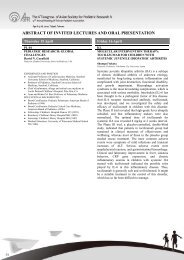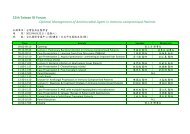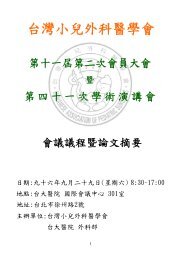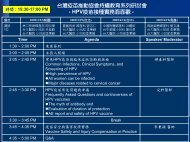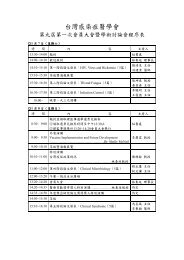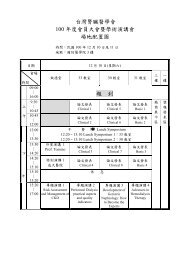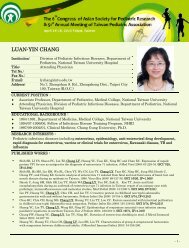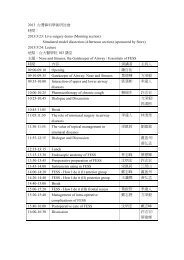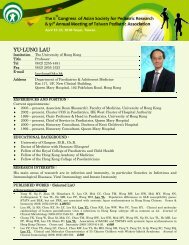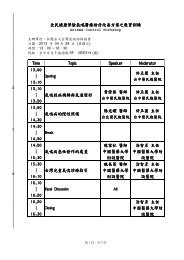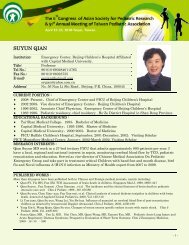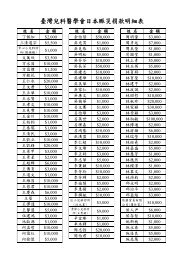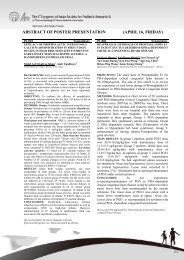P2-007 Allergy/Immunology/Rheumatology P2-008 Allergy/Immunology/RheumatologyCHANGE IN PLAMSA LEVEL <strong>OF</strong> SOLUBLEE- SELECTIN AND+A561C POLYMORPHISMSIN CHILDREN WITH KAWASAKI DISEASEZENG Hua-song, CHEN gang, YU ming-hua, et alGuangzhou children's Hospital, Guangzhou, ChinaOBJECTIVE: To investigate the correlationbetween E-selectin. E-selectin A561C polymorphismand kawasaki disease (KD).METHODS: The plamsa level of E-selectin wasdetermined by ELISA. PCR-RFLP method was usedto determine +A561C locus mutation polymorphismsin E-selectin gene The gene polymorphisms wereconfirmed by sequenceing.RESULT: ES levels in the acute phase group(193±29 ng/ ml), subacute phase group (150±48 ng/ml) were significantly higher than those in thecontrol group( P < 0.01). The peak level of ES(193±29 ng/ ml) appeared in the acute phase. PlasmaES levels of CAL group were significantly higherthan those of NCAL group in the acute phase.(226±36vs158±31 ng/ ml) (P < 0.01).E-selectin gene+A561Cpolymorphism was exiting in children, thefrequency of E-selectin AA genotype was the highestamong E-selectin genotypes (92.5%), ACgenotype(7.5%), and these gene polymorphisms hadno difference between male and female (P>0.05).The allele frequencies of +A561C site of E-selectingene have no significant difference between childrenwith KD and normal controls, also between CAL andNCAL .There were no significant differences in thelevels of ES among different genotypes.CONCLUSION: E-selectin may potentially be apredictor of CAL in children with KD. AlthoughE-selectin levels were significantly elevated in theacute stage of KD, +A561C polymorphism do notconfer a relevant role in the susceptibility or CALdevelopment of KD.[Keywords]E-selectin;Kwasaki disease;Single NucleotidePolymorphismsPRODUCTION <strong>OF</strong> INTERLEUKIN-4,INTERLEUKIN-10, AND INTERFERON-Γ FROMCD4+ T CELLS AND CD8+ T CELLS INPATIENTS WITH ASTHMAJong Seo Yoon, Su Jung Kim, Eugene Kim, Hyun Hee Kim,Jin Tack Kim, Jin Han Kang, Joon Sung LeePediatrics, Kangnam St. Mary’s Hospital, The Catholic University of Korea,KoreaPURPOSE: T cells play an important role in thepathophysiology of asthma and control the activity ofother inflammatory cells in the airway by the release ofcytokines. It has been thought that CD4+ T cells aremostly involved in the exacerbation of asthma, andCD8+ T cells are involved in the suppression of airwayhyperresponsiveness and inflammation. However, recentstudies have reported that CD8+ T cells produce type 2cytokines and cause inflammatory response in theairway in asthma patients. In this study, house dust miteandvirus-stimulated cytokine production in T cells wasexamined.METHODS: Whole blood samples were obtained fromhealthy control and asthma patients, and peripheralblood mononuclear cells (PBMC) were separated. ThePBMC were exposed to Dermatophagoides farinae (derf1), respiratory syncytial virus, rhinovirus, andadenovirus; the number of CD4+ and CD8+ Tcells—which produce interleukin-4, interleukin-10, andinterferon-γ—were determined using flow cytometry.RESULTS: When stimulated with der f1, the productionof interleukin-4 by CD4+ T cells and CD8+ T cells washigher in asthma patients than in healthy controls. Whenexposed to der f1 or viruses, the production ofinterferon-γ by CD8+ T cells was higher in healthycontrols than in asthma patients. Production ofinterleukin-10 was not found in both groups.Conclusion: It is possible that CD8+ T cells are involvedin airway inflammation with an increase in interluekin-4production and decrease in interferon-γ production inasthma patients.258
P2-009 Allergy/Immunology/Rheumatology P2-010 Allergy/Immunology/RheumatologyCLINICAL FEATURES AND PERFORIN A91VGENE ANALYSIS IN SO-JIA CHILDRENWITH MACROPHAGE ACTIVATIONTHE IMMUNOLOGICAL ALTERATION ANDGENE MUTATIONS IN COMBINEDIMMUNODEFICIENCYSYNDROMEZeng Huasong 1,2 *,Chen Xiangyuan 2 *,XiongXiaoyian 2 *,Wei Yandan 2 *, Luo Xiaoping 1§1 Pediatric Department, Tongji Hospital, Tongji Medical College, HuazhongUniversity of Science and Technology, Wuhan, Hubei,China; 2 Departmentof Allergy,Immunology and Rheumatology, Guangzhou Children’sHospital ,Guangzhou Woman and Children’s Medical Center,GuangzhouMedical College,Guangzhou ,Guangdong,China; Supported Grants werefunded by the Science and Technology Commission Research Grants ofGuangzhou City Governments(2003Z2-E0181, 2005Z1-E0104), theScience and Technology Commission Research Grant of GuangdongGovernment(2003B30503), the Science and Technology CommissionResearch Grants of National Ministry of Personnel(200499),PRCBACKGROUND: Macrophage activation syndrome(MAS) is a severe, potentially life-threateningsyndrome.Here we aim to review the clinical featuresincluding precipitating events, clinical features, treatment,outcome and perforin A91V gene analysis in systemiconset juvenile idiopathic arthritis (SoJIA) children withMAS.METHODS: Retrospective review of cases of MAS froma collected database of fourteen children with SoJIA from2003 to 2008. Gene-specific polymerase chain reaction(PCR) primers were used to analyze the perforin A91Vgene polymorphism.RESULTS: Fourteen patients(nine boys) were consideredto have evidence of MAS, with age ranged from 4 monthsto 12 years.The primary diagnosis was systemic onsetjuvenile idiopathic arthritis.No medication was identifiedas trigger. Eleven had infections prior to MAS, specificinfectious agents were identified in four. High fever, newonset hepatosplenomegaly, lymphadenopathy, liverdysfunction, abnormal lipid metabolism andhemophagocytosis were common clinical features.Twocases were with acute respiratory distress syndrome(ARDS), multiple organ failure (M<strong>OF</strong>) in three and threedied. The perforin A91V (NCBI: SNP rs35947132) variantgene was detected in seven systemic onset juvenileidiopathic arthritis compolicated with MAS cases, but nomutation were found..Glucocorticoid, intravenousimmunoglobulin, immunoimpressive therapy wereeffective and HP (Plasmapheresis) used in one serious casewas also effective.CONCLUSIONS: MAS is a rare and potentially fatalcomplication of childhood rheumatoid diseases, especiallysystemic onset juvenile idiopathic arthritis. Most of ourpatients were male, and most cases were preceded byinfection. Bone marrow studies support the diagnosis.M<strong>OF</strong> may be a poor prognostic sign.Aggressive earlytherapy is essential.[Keywords] perforin, macrophage, activation, syndrome,juvenileidiopathic arthritisYing-Ying Jin 1 , Rui-Ming Cao 2 , Tong-Xin Chen 1,21 Department of Pediatrics, Xinhua Hospital, Shanghai Jiao Tong UniversitySchool of Medicine, Shanghai, China; 2 Department of Immunology/Oncology,Shanghai Institute for Pediatric Research, Shanghai Jiao Tong University Schoolof Medicine, Shanghai, ChinaOBJECTIVE: The aim of this study was to investigate theimmunological features and characteristic of gene mutation inChinese patients with combined immunodeficiency to furtherensure the early diagnosis and therapy for children suffering fromcombined immunodeficiency.METHODS: Case histories were analyzed repeatedly to graspimportant characteristics of the diseases. Distribution oflymphocyte subsets from peripheral blood and the level of CD40Lexpressing on activated CD3+CD8- T lymphocyte surface wereexamined by flow cytometry. Amplify and identify exons fromgenes encoding CD40L and IL-2Rγc by PCR and agarose gelelectrophoresis, and then followed by gene sequencing.MAIN RESULTS: Among 124 patients with primaryimmunodeficiency diseases, 14 (11.29%) were diagnosed ascombined immunodeficiency. Four of them were X-linked HyperIgM Syndrome (XHIGM), among which three has gene diagnosis:two deletion mutation, one insertion mutation. All the four patientswhose clinical manifestations included recurrent dental ulcer,persisitent neutropenia and arthritis had obviously decreased serumIgG and IgA level, increased but one within normal range serumIgM level. All of them showed normal distribution of lymphocytesubsets, and obviously decreased CD40L expression level. Tenpatients were diagnosis as severe combined immunodeficiency(SCID), eight belonged to X-linked kind (XSCID) including fourgene diagnosis: two missense mutation, one deletion mutation andone deletion mutation combined with insertion mutation. The restbelonged to none X-linked type. The ten patients whose clinicalmanifestations included recurrent upper respiratory infection andpneumonia, thrush and other kinds of fungous infections andGVHD had obviously all kinds of serum immunoglobulin levelsdecreased. All XSCID patients showed obviously decreasedpropotion of T and NK cells but increased B cells. One noneXSCID patient showed decreased propotion of T cells and B cellsbut increased NK cells while the other one had decreasedpropotion of all kinds of lymphocyte subsets.CONCLUSIONS: For male patient suspected with combinedimmunodeficiency primary diagnosis could be made on the basisof early recurrent infection involved respiratory and alimentarysystem, with no satisfactory response to antibiotic, within orwithout the same cases occurred in maternal family history,combined with certain changes in all kinds of serumimmunoglobulin level and absolute lymphocyte counts. Thensequent secreening methods of XHIGM and SCID will be needed,including analyzing the distribution of lymphocyte subsets fromperipheral blood and the level of CD40L expressing on activatedCD3+CD8- T lymphocyte surface by flow cytometry. Finaldiagnosis could be conducted by gene sequencing.[Keywords]immunological alteration; gene mutations; combinedimmunodeficiency259



